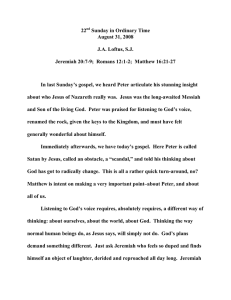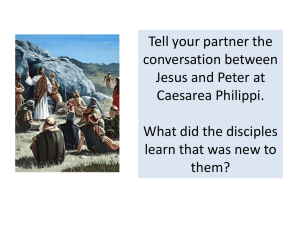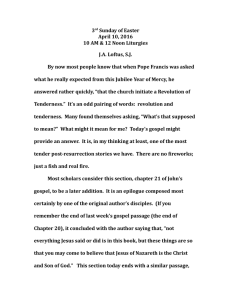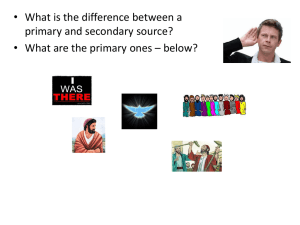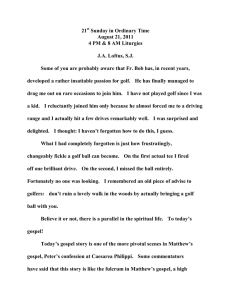Brent`s Week 1 Reflection
advertisement
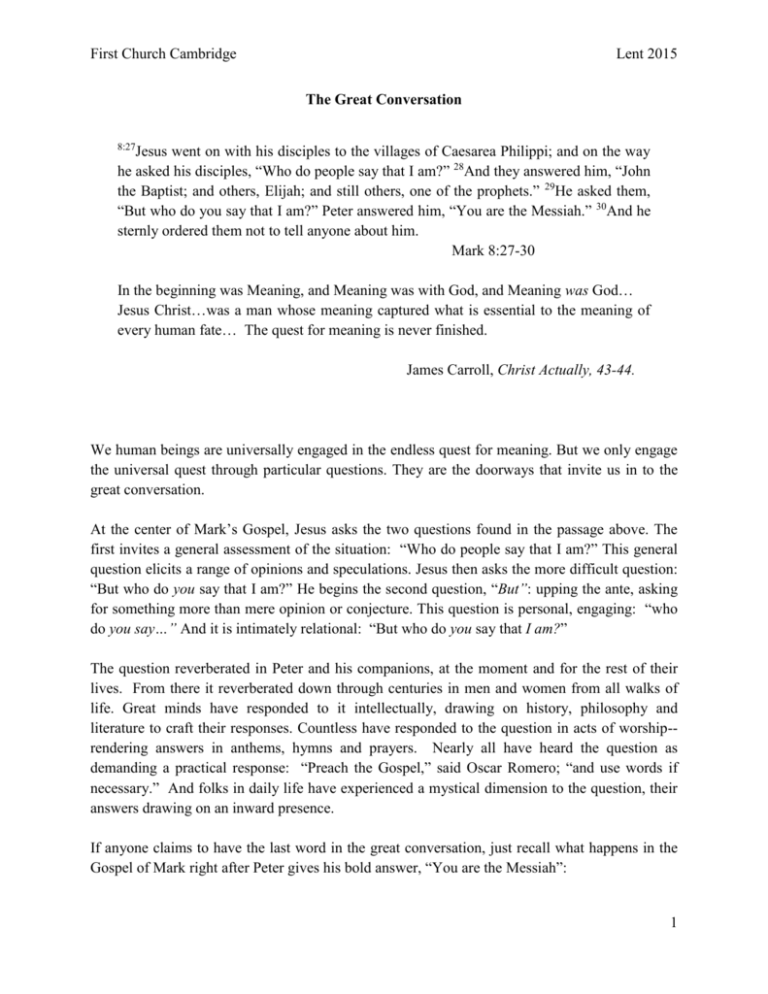
First Church Cambridge Lent 2015 The Great Conversation 8:27 Jesus went on with his disciples to the villages of Caesarea Philippi; and on the way he asked his disciples, “Who do people say that I am?” 28And they answered him, “John the Baptist; and others, Elijah; and still others, one of the prophets.” 29He asked them, “But who do you say that I am?” Peter answered him, “You are the Messiah.” 30And he sternly ordered them not to tell anyone about him. Mark 8:27-30 In the beginning was Meaning, and Meaning was with God, and Meaning was God… Jesus Christ…was a man whose meaning captured what is essential to the meaning of every human fate… The quest for meaning is never finished. James Carroll, Christ Actually, 43-44. We human beings are universally engaged in the endless quest for meaning. But we only engage the universal quest through particular questions. They are the doorways that invite us in to the great conversation. At the center of Mark’s Gospel, Jesus asks the two questions found in the passage above. The first invites a general assessment of the situation: “Who do people say that I am?” This general question elicits a range of opinions and speculations. Jesus then asks the more difficult question: “But who do you say that I am?” He begins the second question, “But”: upping the ante, asking for something more than mere opinion or conjecture. This question is personal, engaging: “who do you say…” And it is intimately relational: “But who do you say that I am?” The question reverberated in Peter and his companions, at the moment and for the rest of their lives. From there it reverberated down through centuries in men and women from all walks of life. Great minds have responded to it intellectually, drawing on history, philosophy and literature to craft their responses. Countless have responded to the question in acts of worship-rendering answers in anthems, hymns and prayers. Nearly all have heard the question as demanding a practical response: “Preach the Gospel,” said Oscar Romero; “and use words if necessary.” And folks in daily life have experienced a mystical dimension to the question, their answers drawing on an inward presence. If anyone claims to have the last word in the great conversation, just recall what happens in the Gospel of Mark right after Peter gives his bold answer, “You are the Messiah”: 1 First Church Cambridge Lent 2015 8:31 Then [Jesus] began to teach them that the Son of Man must undergo great suffering, and be rejected by the elders, the chief priests, and the scribes, and be killed, and after three days rise again. 32He said all this quite openly. And Peter took him aside and began to rebuke him. 33But turning and looking at his disciples, he rebuked Peter and said, “Get behind me, Satan! For you are setting your mind not on divine things but on human things.” (8:31-33) A Jew living in trying times, Peter gave his most profoundly hopeful answer to Jesus’ question. Yet he didn’t understand the meaning of what he said. As Karin Case explained in her sermon last Sunday, that would require Peter and his companions to continue on the way. So now the question comes to us. Not as an abstract, theoretical matter… not as an opportunity to opine on what others say: It comes as from one who wants to know what we have to say; indeed, from one who needs to know, because it’s not about him alone. It’s about who we are in relation to Jesus and the God he promises to be with us. Emphasis on us: The great conversation doesn’t come alive in the confined spaces of our separate individuality, nor is it carried on in the public babel of sound bites and polemics. It comes alive when two or more are gathered, repeatedly, over time. It lives in the spaces between us, as we become more fully a community of dialogue. It happens when we articulate not only our questions and concern, but also dare to articulate the faith and convictions by which we live and die, in good days and bad, in the present time and for those to come. A year ago I visited an exhibition featuring the portraiture of Henri Matisse. Matisse adored his only daughter Marguerite and painted numerous portraits of her throughout his life. In 1944 Marguerite was captured by the Gestapo, imprisoned and tortured for aiding the French Resistance. When she managed to escape and return home in 1945, her father was more than overjoyed. He was in awe of the mystery of who Marguerite had become. Matisse felt compelled to sketch a charcoal image of this intimate stranger. Then over time, he transposed onto that image the strong lines that created other portraits. Those strong lines expressed how Matisse continued to see his beloved daughter. But they never exhausted the mystery of who Marguerite actually was. This is our time in the great conversation. What strong lines will we add? 2


